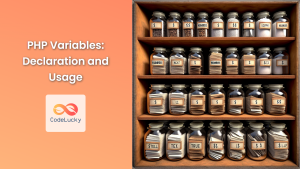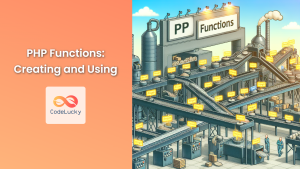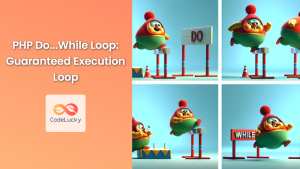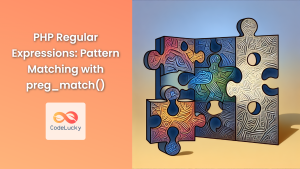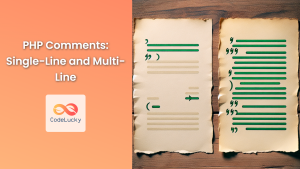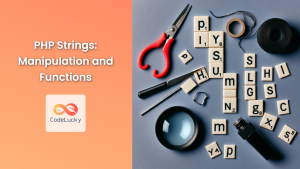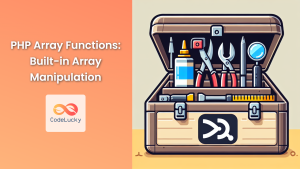PHP, the powerhouse of server-side scripting, is known for its flexibility and ease of use. But to harness its full potential, you need to understand its syntax and structure. In this comprehensive guide, we’ll dive deep into the fundamental rules that govern PHP code, exploring its basic structure and providing you with practical examples to solidify your understanding.
The PHP Tag: Where It All Begins
Every PHP script starts and ends with a specific tag. This tag tells the server that the enclosed code should be processed as PHP. Let’s look at the different ways you can define PHP tags:
Standard Tags
The most common and recommended way to define PHP code is using the standard tags:
<?php
// Your PHP code goes here
?>
Short Echo Tag
For quick output, you can use the short echo tag:
<?= "Hello, CodeLucky!" ?>
This is equivalent to:
<?php echo "Hello, CodeLucky!"; ?>
🚀 Pro Tip: While short tags (<?) and ASP tags (<%) exist, they’re not recommended due to potential compatibility issues.
Statements and Semicolons
In PHP, each statement is typically followed by a semicolon (;). This punctuation mark is crucial as it signifies the end of a command. Let’s see it in action:
<?php
$name = "CodeLucky";
echo "Welcome to " . $name;
$number = 42;
?>
In this example, we have three distinct statements, each terminated by a semicolon.
⚠️ Warning: Forgetting semicolons is a common mistake for beginners. Always double-check your code!
Comments in PHP
Comments are non-executable lines in your code that help explain what’s happening. PHP supports three types of comments:
Single-line Comments
Use // for single-line comments:
<?php
// This is a single-line comment
$score = 95; // You can also add comments at the end of a line
?>
Multi-line Comments
For longer explanations, use / / to create multi-line comments:
<?php
/*
This is a multi-line comment.
It can span several lines.
Very useful for detailed explanations.
*/
$complexCalculation = ($a + $b) * ($c - $d);
?>
Doc Comments
Doc comments (/* /) are special multi-line comments used for documentation:
<?php
/**
* Calculates the sum of two numbers
* @param int $a First number
* @param int $b Second number
* @return int The sum of $a and $b
*/
function add($a, $b) {
return $a + $b;
}
?>
💡 Insight: Well-commented code is easier to understand and maintain, especially in large projects or when working in teams.
Case Sensitivity in PHP
PHP is partially case-sensitive. Let’s break it down:
- Variables are case-sensitive
- Function names are case-insensitive
- Constants defined using
define()are case-sensitive by default
Here’s an example to illustrate:
<?php
$color = "red";
$Color = "blue";
echo $color; // Outputs: red
echo $Color; // Outputs: blue
function sayHello() {
echo "Hello from sayHello()";
}
sayHello(); // Works
SayHELLO(); // Also works
define("GREETING", "Welcome to CodeLucky");
echo GREETING; // Works
echo greeting; // Doesn't work (Notice: Undefined constant)
?>
🎨 CodeLucky Tip: While PHP allows for case-insensitive function calls, it’s a good practice to maintain consistent casing for better code readability.
Whitespace and Line Breaks
PHP is quite flexible when it comes to whitespace and line breaks. Extra spaces or line breaks don’t affect the code execution. This allows developers to format their code for better readability. Let’s see an example:
<?php
$fruit="apple";$color="red";$taste="sweet";
// The above line is equivalent to:
$fruit = "apple";
$color = "red";
$taste = "sweet";
// Both will work the same way
echo "The $fruit is $color and $taste.";
?>
Output:
The apple is red and sweet.
While both styles work, the second one is much more readable and maintainable.
PHP and HTML Integration
One of PHP’s strengths is its seamless integration with HTML. You can switch between PHP and HTML effortlessly:
<!DOCTYPE html>
<html>
<head>
<title>PHP and HTML Integration</title>
</head>
<body>
<h1>Welcome to <?php echo "CodeLucky"; ?></h1>
<?php
$courses = array("PHP", "JavaScript", "Python");
echo "<ul>";
foreach ($courses as $course) {
echo "<li>$course</li>";
}
echo "</ul>";
?>
<p>Happy coding!</p>
</body>
</html>
This will generate an HTML page with a dynamic heading and list of courses.
🌟 CodeLucky Insight: This integration allows for creating dynamic web pages where content can change based on various factors like user input, database queries, or time of day.
Variables and Data Types
In PHP, variables are declared using the $ symbol followed by the variable name. PHP is a loosely typed language, meaning you don’t need to declare the type of a variable explicitly.
<?php
// String
$name = "CodeLucky";
// Integer
$year = 2023;
// Float
$pi = 3.14159;
// Boolean
$isAwesome = true;
// Array
$colors = array("red", "green", "blue");
// Null
$emptyVar = null;
// Printing variables
echo "Welcome to $name!<br>";
echo "Current year: $year<br>";
echo "Value of pi: $pi<br>";
echo "Is CodeLucky awesome? " . ($isAwesome ? "Yes!" : "No") . "<br>";
echo "First color: " . $colors[0] . "<br>";
echo "Empty variable: " . var_export($emptyVar, true) . "<br>";
?>
Output:
Welcome to CodeLucky!
Current year: 2023
Value of pi: 3.14159
Is CodeLucky awesome? Yes!
First color: red
Empty variable: NULL
💡 Pro Tip: Use var_dump() function to get detailed information about a variable, including its type and value.
Constants
Constants in PHP are identifiers for simple values that cannot be changed during the script execution. They are defined using the define() function or the const keyword.
<?php
// Using define()
define("PI", 3.14159);
// Using const (PHP 5.3.0 and later)
const GRAVITY = 9.8;
echo "The value of PI is " . PI . "<br>";
echo "The acceleration due to gravity is " . GRAVITY . " m/s²";
?>
Output:
The value of PI is 3.14159
The acceleration due to gravity is 9.8 m/s²
🔒 CodeLucky Note: Constants are global across the entire script and cannot be redefined once set.
Operators in PHP
PHP supports a wide range of operators for performing operations on variables and values. Here’s a quick overview:
Arithmetic Operators
<?php
$a = 10;
$b = 3;
echo "Addition: " . ($a + $b) . "<br>"; // 13
echo "Subtraction: " . ($a - $b) . "<br>"; // 7
echo "Multiplication: " . ($a * $b) . "<br>"; // 30
echo "Division: " . ($a / $b) . "<br>"; // 3.3333333333333
echo "Modulus: " . ($a % $b) . "<br>"; // 1
echo "Exponentiation: " . ($a ** $b) . "<br>"; // 1000
?>
Comparison Operators
<?php
$x = 5;
$y = "5";
var_dump($x == $y); // bool(true) - Equal
var_dump($x === $y); // bool(false) - Identical
var_dump($x != $y); // bool(false) - Not equal
var_dump($x !== $y); // bool(true) - Not identical
var_dump($x < 10); // bool(true) - Less than
var_dump($x >= 5); // bool(true) - Greater than or equal to
?>
Logical Operators
<?php
$a = true;
$b = false;
var_dump($a && $b); // bool(false) - And
var_dump($a || $b); // bool(true) - Or
var_dump(!$a); // bool(false) - Not
?>
🧠 CodeLucky Insight: Understanding operators is crucial for writing efficient PHP code, especially when dealing with conditional statements and loops.
Control Structures
Control structures are the backbone of programming logic. PHP offers several control structures to manage the flow of your script.
If-Else Statement
<?php
$hour = 14;
if ($hour < 12) {
echo "Good morning!";
} elseif ($hour < 18) {
echo "Good afternoon!";
} else {
echo "Good evening!";
}
?>
Output:
Good afternoon!
Switch Statement
<?php
$dayNumber = 3;
switch ($dayNumber) {
case 1:
echo "Monday";
break;
case 2:
echo "Tuesday";
break;
case 3:
echo "Wednesday";
break;
case 4:
echo "Thursday";
break;
case 5:
echo "Friday";
break;
default:
echo "Weekend";
}
?>
Output:
Wednesday
Loops
PHP supports several types of loops:
For Loop
<?php
echo "Counting from 1 to 5:<br>";
for ($i = 1; $i <= 5; $i++) {
echo $i . " ";
}
?>
Output:
Counting from 1 to 5:
1 2 3 4 5
While Loop
<?php
$count = 0;
echo "Even numbers less than 10:<br>";
while ($count < 10) {
if ($count % 2 == 0) {
echo $count . " ";
}
$count++;
}
?>
Output:
Even numbers less than 10:
0 2 4 6 8
Do-While Loop
<?php
$i = 1;
do {
echo $i . " ";
$i *= 2;
} while ($i <= 32);
?>
Output:
1 2 4 8 16 32
Foreach Loop
<?php
$fruits = array("Apple", "Banana", "Cherry", "Date");
echo "List of fruits:<br>";
foreach ($fruits as $fruit) {
echo "- $fruit<br>";
}
?>
Output:
List of fruits:
- Apple
- Banana
- Cherry
- Date
🎭 CodeLucky Drama: Imagine your code as a stage play. Control structures are like the director, deciding which scenes (code blocks) should be performed and in what order!
Functions
Functions are reusable blocks of code that perform specific tasks. They help in organizing code and promoting reusability.
<?php
function greet($name, $language = "English") {
switch ($language) {
case "French":
return "Bonjour, $name!";
case "Spanish":
return "Hola, $name!";
default:
return "Hello, $name!";
}
}
echo greet("Alice") . "<br>";
echo greet("Pierre", "French") . "<br>";
echo greet("Carlos", "Spanish") . "<br>";
?>
Output:
Hello, Alice!
Bonjour, Pierre!
Hola, Carlos!
💼 CodeLucky Pro Tip: Functions can have default parameter values, making them more flexible and easier to use in different scenarios.
Error Handling
Proper error handling is crucial for developing robust PHP applications. PHP provides several ways to handle errors:
Try-Catch Blocks
<?php
function divide($numerator, $denominator) {
if ($denominator == 0) {
throw new Exception("Division by zero!");
}
return $numerator / $denominator;
}
try {
echo divide(10, 2) . "<br>"; // This will work
echo divide(5, 0); // This will throw an exception
} catch (Exception $e) {
echo "Caught exception: " . $e->getMessage();
} finally {
echo "<br>This will always execute.";
}
?>
Output:
5
Caught exception: Division by zero!
This will always execute.
🛡️ CodeLucky Shield: Error handling acts like a shield for your application, gracefully managing unexpected situations and preventing crashes.
Conclusion
Understanding PHP syntax and structure is the foundation for becoming a proficient PHP developer. From basic tags and variables to complex control structures and error handling, each element plays a crucial role in creating robust and efficient PHP applications.
Remember, practice makes perfect. Try out these examples, experiment with your own code, and don’t be afraid to make mistakes – they’re often the best teachers in programming!
Happy coding with CodeLucky! 🚀💻




